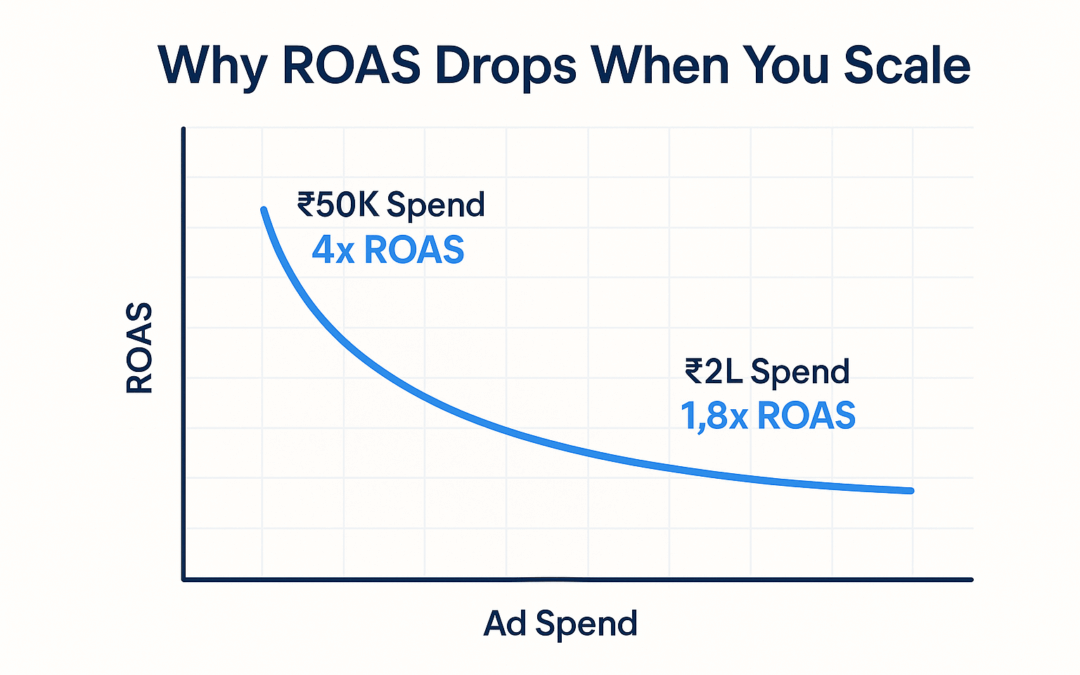If ₹50K in ads brings a 4x return, then spending ₹2L should bring more, right? Wrong. As you increase spend, costs rise, clicks slow down, and that 4x quickly drops to 1.8x. It’s not that your ads stopped working – it’s that ROAS doesn’t grow in a straight line. The bigger you scale, the more pressure hits every part of your system.
In this blog, we’ll break down why scaling ROAS gets tougher in ecommerce advertising, even when your creatives and product are on point. Because when you start pushing spend, a few hidden factors quietly start chipping away at your returns, starting with tracking itself.
- Algorithmic Bias Toward ‘Easy Wins’
Ad platforms don’t care about your profit; they care about consistency. Meta and Google’s algorithms are built to find easy conversions, not long-term growth. Once they spot a small group of people who convert well, they keep showing ads to that same group until it stops working. It’s good for the platform but bad for scaling.
When you increase your budget, the algorithm has to reach new, colder audiences. That’s when click rates drop, costs rise, and ROAS starts to fall. In e-commerce advertising, this bias often limits how far your campaigns can truly scale.
Simply put:
The algorithm protects its own stability – not your margins. That’s why your ads perform well at ₹50K a day but start breaking the moment you spend ₹2L.
- Creative Fatigue Outpaces Creative Volume
Even your best ad has a shelf life. Most winning creatives start to slow down after about 1.5–2 million impressions. People have seen them enough times to stop paying attention.
But most brands still produce only two or three new ads a month – when they really need ten or more a week to keep ROAS steady. Without a regular flow of new ideas – fresh hooks, UGC clips, testimonials, offers – your ads lose impact fast.
In e-commerce advertising, creative fatigue isn’t just a performance drop; it’s a growth bottleneck. Scaling isn’t about spending more money. It’s about showing your audience something new before they tune out. The more you refresh your creatives, the longer your ROAS stays strong.
- AOV Doesn’t Grow with CAC
You can’t grow ads if your numbers don’t add up. When you spend more on ads, your cost to get each customer (CAC) always goes up. But most brands still sell the same low-priced product. If you’re spending ₹300 – ₹400 to get a sale and your product costs ₹499, there’s hardly any profit left. The solution? Make each customer worth more. Here’s how:
- Create bundles: Combine related products so every order is higher in value without increasing your ad cost.
- Use tiered pricing: Offer larger sizes or premium versions to give customers a reason to spend more.
- Add post-purchase offers: Show add-ons or upgrades right after checkout as customers are in a buying mindset
Because when each customer is worth more, your ad spend finally starts working for you, not against you.
- Audience Overlap & Auction Pressure
Meta’s 2025 auction data shows that ad sets with over 30% audience overlap face up to 40% higher CPMs (Cost Per Mille). In other words, as you scale your budget, you’re not just competing with other advertisers – you’re competing with yourself. Scaling doesn’t fail because Meta penalises you; it fails because your own campaigns drive costs up. To fix this, start by checking audience overlap in Ads Manager. Merge similar ad sets, and make sure to exclude recent buyers or frequent visitors. This helps your ads reach fresh audiences instead of recycling the same users at higher costs.
- Weak Mid-Funnel Storytelling
Most brands don’t have a proper mid-funnel setup. They run great awareness ads but skip the step where people actually learn to trust the brand. Without product demos, testimonials, or user-generated content, new visitors never move from interest to action.
When you start scaling, this problem only gets bigger. You send more people into the same weak funnel – more clicks, same drop-off.
The issue isn’t ad fatigue; it’s story fatigue. Build a simple mid-funnel flow: start with awareness, follow with education, add social proof, and end with a clear offer. This helps people connect the dots – and makes your ad spend go further.
- Poor Landing Page Latency at High Volume
A landing page that loads fine with 500 visitors a day can start to slow down once traffic crosses 2,000. Heavy images, too many tracking scripts, or weak hosting servers all add extra load time. And even a one-second delay can hurt more than you think – bounce rates can rise by 5–10%, and conversions drop just as fast.
So while your ad spend goes up, your site silently leaks revenue. The worst part? You won’t see it on your ad dashboard – everything looks fine until you check your analytics.
Fix it before scaling: compress images, limit third-party pixels, upgrade hosting, and monitor page speed under load. Because no matter how good your ads are, a slow site kills ROAS faster than a bad campaign.
Conclusion
By now, you’ve probably noticed why numbers dip when you scale. It’s not because Meta’s out to get you or your ads suddenly stopped working. It’s usually because the backend – tracking, creative volume, funnel setup, pricing, even website load time – can’t keep pace with the front end. Once you see that, you stop obsessing over ROAS and start fixing what actually drives it.
When these systems tighten up, scaling stops feeling like a guessing game. Your tracking gets sharper, creatives last longer, AOV stretches further, and your funnel finally starts pulling its weight. That’s when scaling turns from chaotic spend into predictable, sustainable growth. At Brandshark, a digital marketing agency in Bangalore, we help e-commerce brands build the kind of creative, performance, and funnel setup that keeps ROAS stable even when budgets grow. Not sure what’s holding back your ROAS? We’ll help you find out. Get in touch with us today

